Pilonidal Sinus and Pilonidal Cyst

Pilonidal sinus is a condition that affects the tissue midline in the lower back. It is caused by an accumulation of hair and debris in the area, which can lead to an infection. Pilonidal sinus is more common in men than women, and people with a family history of the condition are also more likely to develop it. Symptoms of pilonidal sinus include pain, swelling, and discharge from the affected area. If left untreated, pilonidal sinus can lead to severe complications, such as cellulitis or abscess.
Pilonidal cysts are saclike pockets of tissue that form along the tailbone, typically at the point where the buttocks crease. Pilonidal cysts are believed to develop when hair follicles become irritated or infected. Although anyone can develop a pilonidal cyst, they’re most often seen in young adults, especially men. Pilonidal cysts often contain debris, such as hair, skin cells, and dirt.
Signs and Symptoms
Pilonidal cysts usually don’t cause any symptoms unless they become infected. Infected pilonidal cysts are often painful and may drain pus or blood. Sitting may become difficult, and pain may worsen when seated.
There may be foul-smelling fluid (Pus), and the patient may experience nausea, fever, and fatigue.
Diagnosis and tests
The pilonidal cyst can be diagnosed on examination. You may be advised to have a CT scan or MRI to look for any pilonidal sinus cavities under the surface of the skin or to delineate any tract.
Treatment
There are two treatment options. First is the traditional way of excising the entire tract, followed by a flap closure for the open wound. The second option, which is gaining popularity and interest, is the laser approach, where the tract is ablated using a laser without any big open wound, preventing any scar.
If you have a pilonidal cyst causing pain or drainage, your doctor may recommend draining or removing it surgically. Sometimes, you may need to have the affected area of your skin closed with stitches (wound closure). If you have recurrent pilonidal cysts, your doctor may recommend more extensive surgery to remove the affected tissue and prevent future cysts from developing.
